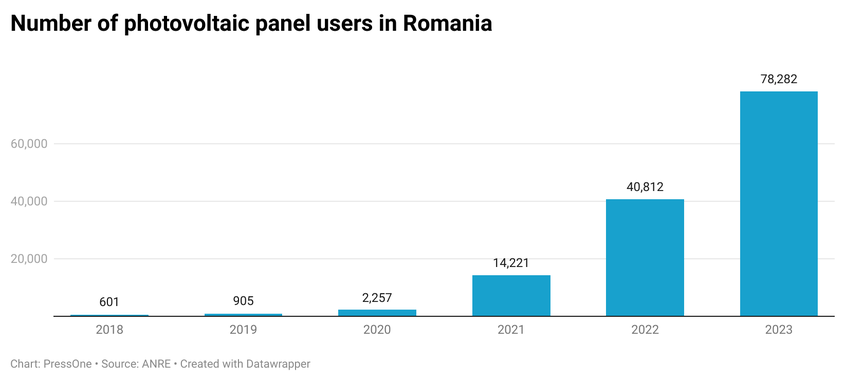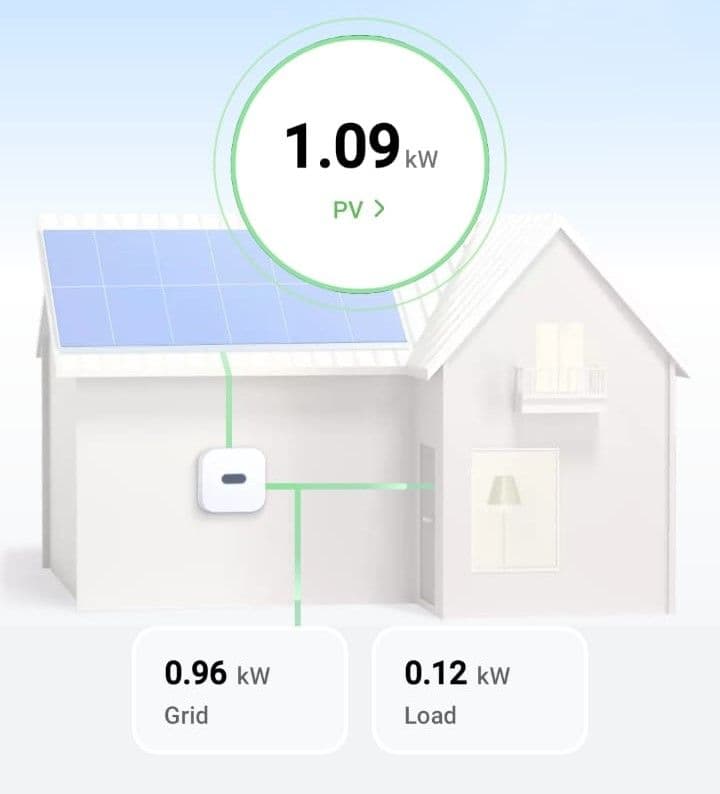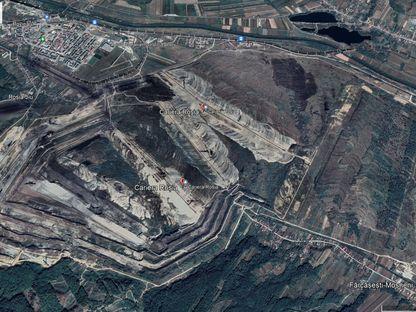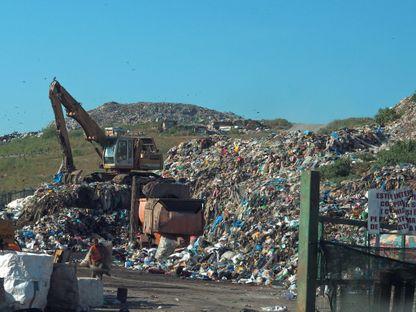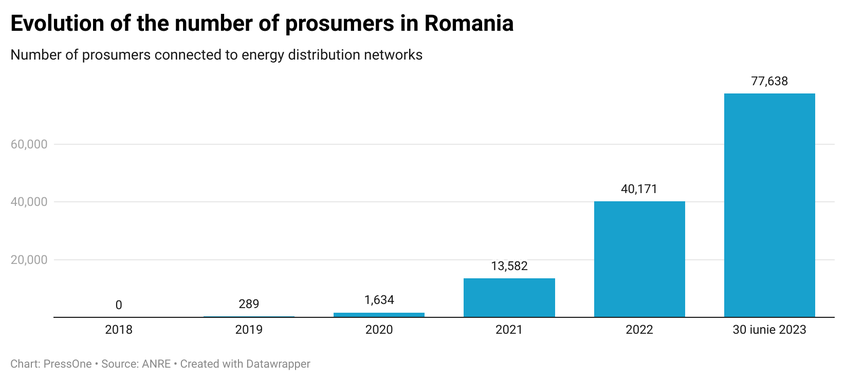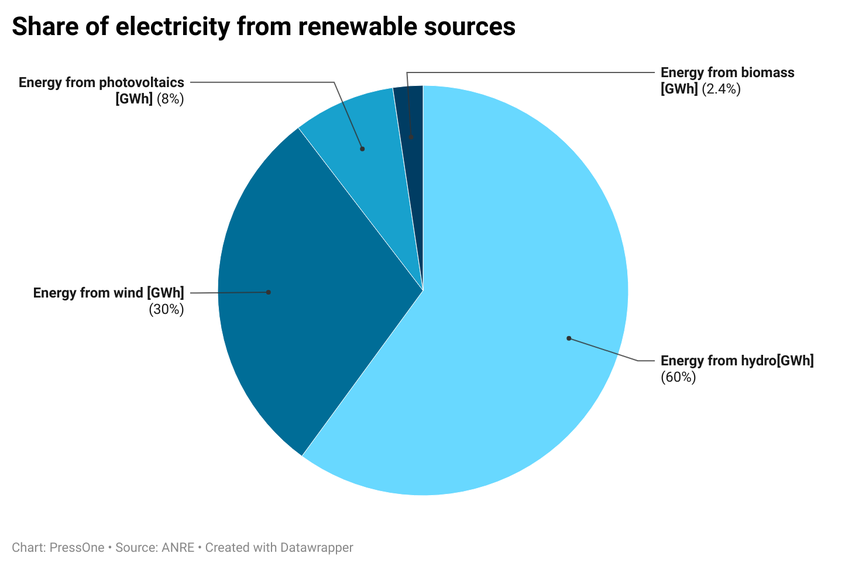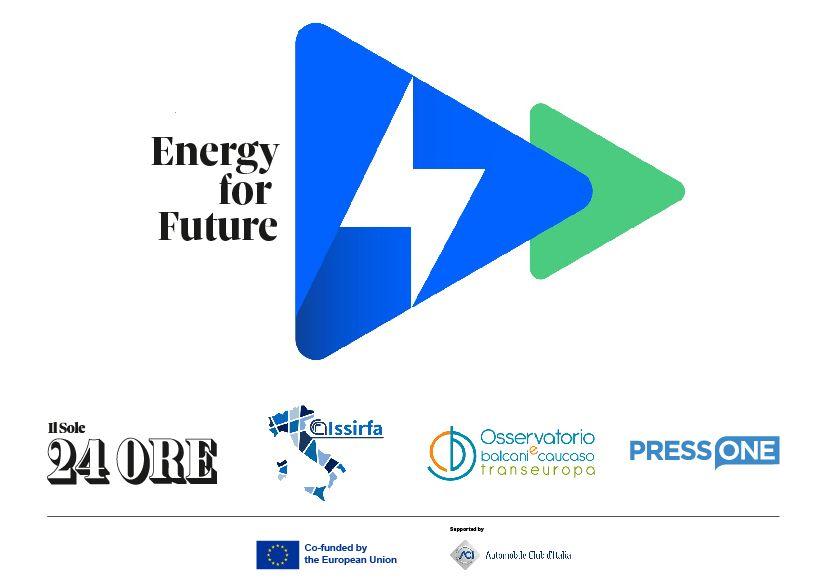Solar panels could become commonplace in Romania's villages if RePowerEU money is managed properly. Photo © Andrii Biletskyi | Dreamstime.com
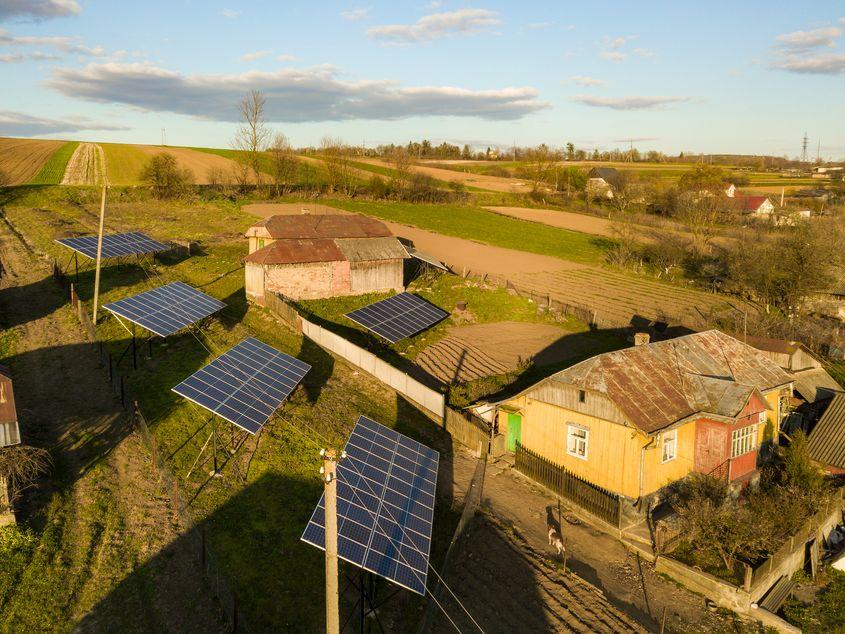
Solar panels could become commonplace in Romania's villages if RePowerEU money is managed properly. Photo © Andrii Biletskyi | Dreamstime.com
14/02/2024
The not-so-green Romania. The state delays settlements for photovoltaic panels by 2 years
The Romanian government has increased VAT on photovoltaic panels from the current 5% to 9%, in a new tax package caused by the budget hole. However, consumers and installers of photovoltaic panels complain to PressOne that this increase is in fact the least of their problems. In reality, Romania's efforts to make the transition to green energy, which it undertook in Brussels, hit a brick wall when it comes to working with state institutions, electricity suppliers and distributors.
PressOne reviews the main dysfunctions in the production, consumption and distribution of energy from renewable sources, as revealed by discussions with consumers and data provided by official sources at the request of our editorial office.
What it means to be a „prosumer” in Romania
Romania is catching up every day with Europe in terms of renewable energy. While there were no prosumers in 2018, five years later there are 77,638 connected to the grid. Prosumers are those who consume the energy produced by their own photovoltaic panels, but also produce and inject into the national grid what remains unused.
Thus, at the moment, about 43% of Romania's total electricity comes from natural sources, according to a response provided to PressOne by the National Energy Regulatory Authority (ANRE).
Romanians' interest in photovoltaic panels is best seen in the figures. If in 2018 only 601 Romanians had photovoltaic panels, today the number has reached 78,282.
According to data provided by ANRE, the number of users of photovoltaic panels in Romania is constantly increasing
Rodica Chirculescu lives in Popesti Leordeni, Bucharest, and is among the first prosumers in the country. In December 2019, she applied for the Photovoltaic Green House program, run by the Administration of the Environment Fund (AFM), to benefit from the 20,000 lei offered by the state for the installation of a 3 KWh system. Enough to provide her house with enough electricity.
She also contributed 2,400 lei (approx. 500 euros), but the panels were not installed until May 2021. "Then someone came along and made the connections to the grid. I also got a bit carried away and I really became a prosumer in mid-October," Rodica tells us.
Since then, she has not paid a single electricity bill, but neither has she been compensated for the surplus energy that was left unused and injected into the grid.
Mulți ne citesc, puțini ne susțin. Fără ajutorul tău, nu putem continua să scriem astfel de articole. Cu doar 5 euro pe lună ne poți ajuta mai mult decât crezi și poți face diferența chiar acum!
On a day in August 2023, Rodica shows us, her panels produce 1.09 KW. Of this, only 0.12 kW is consumed in the house, the remaining 0.96 kW automatically goes into the grid.
On an August day, Rodica's panels produce more than 1 kWh, of which more than three-quarters goes into the grid. PHOTO: Rodica Chirculescu
She says she has changed her consumption habits with photovoltaic panels.
"I've switched a lot to electric appliances at home, I use less gas. I use the grill, I heat my water in an electric kettle and then I put in my soup water. I use a lot of the energy I produce. Because I produce more than I consume and then it goes into the grid. And for everything that goes into the grid I have to pay for hosting.
Every prosumer puts energy into the distribution network, which, depending on the area of the country, belongs to one company or another. These distribution companies also have tariffs. They each have their own tariff for the energy they take and it shows up on your bill," says Rodica.
Coal Mining Expansion Leads to Deforestation: Over 470 Hectares of Forest Cut Down in Gorj, Romania
Over the past six years, more than 470 hectares of national forest land have been allocated by the government, without compensation, to the Oltenia Energy Complex (CEO) for the expansion or opening of new coal mines.
Romania's waste crisis. After 17 years and billions of euros spent, the recycling rate remains the lowest in the EU
Romania needed nearly two decades to declare its integrated waste management systems operational. Even so, it remains the EU member state with the lowest recycling rate—just 12%, stagnant since 2010—according to a country report discussed by the European Commission in June 2025.
According to an ANRE response sent to PressOne, those who own photovoltaic systems of up to 200 KWh and enter into a sale-purchase contract with an electricity supplier benefit from a quantitative compensation mechanism. But how is the compensation done?
Electricity suppliers would have to invoice how much energy a consumer has delivered to the grid and how much he has consumed when the PV panels have not captured the sun. This calculates the difference between what was delivered and what was consumed, and the difference can be consumed by the consumer from the grid over a period of 24 months from the billing date.
Un newsletter pentru cititori curioși și inteligenți.
Sunt curios
Problems arise, however, when bills are late. Because that's what a lot of consumers complain about, that the electricity supply companies they have contracts with don't send them bills. Neither for what they consumed from the grid nor for what they delivered to the grid.
"The law says that the energy you produce and give to the system is billed to you if you don't consume it. Two years after billing, you get paid. With me, both the consumption bill and the generation bill are somewhere in July or August 2022," complains Rodica, who has all her bills on the minus side, meaning she produces more than she consumes.
The state pays its prosumers with a delay of two years
Rodica is not the only one in this situation. On the prosumers' Facebook groups, missing bills is the most common problem: "Can you tell me, from your experience, a supplier who issues invoices on time?", "Has anyone received invoices on grid injection? I haven't received anything since 17.03.2022, since I became a prosumer!"(editor's note: the message was published in July 2023).
Constantin Bogdan took out a loan and, with about 30,000 lei, installed a photovoltaic panel system with a power of 5.4 kW. He says the process of becoming a prosumer was a slow one: he installed his panels in September 2022, but only became a prosumer in March 2023. That's when he also started delivering what he wasn't using to the grid.
"I haven't received a bill for a year now, although before I became a prosumer I sent the index month after month, and since I became a prosumer, the meter is read by the distribution company on a monthly basis," says Constantin.
However, consumers who do receive their energy bills complain about how they are compensated for what they have delivered to the grid. Specifically, while Law 123/2012 describes the quantitative compensation mentioned above, its application is different.
"You produce 3 kW this month. And let's say you didn't use it. You only consume 1.5 kW and a half. That leaves 1.5 kW. In 2 years' time, i.e. in September 2025, you will receive money at the current price of this 1.5 kW. Not at the price you have now. And that's for each month," says Dumitru Luță, president of the Association of Small Electricity Producers in Romania (AMPEER).
What's more, practice has shown that for every 1 kW consumed from the grid, consumers end up injecting 2-4 kW.
"If you produce 30 kW and consume only 15, that leaves 15. That 15 kW ends up at your neighbor's gate. 50 meters or less. In my case, they are taken for 67 money and passed on to my neighbor for 1.3 lei, the cost of one kW. So, per 50 meters, from 67 money it ends up costing twice as much. And when I take from the grid, for consumption, I still get 1.3 lei", explains the president of the Association of Small Electricity Producers in Romania.
There are currently several lawsuits against ANRE for Order no. 15/2022 which sets out how compensation of prosumers takes place.
Romania's solar energy potential is estimated at 3,574 kWh/m2 per day, according to ESMAP (Global Photovoltaic Power Potential by Country) indices, as quoted by Info Clima experts. Romania ranks 182nd out of 210 countries surveyed.
According to data provided by ANRE, in 2022 the share of electricity from renewable resources in Romania was 42.3%
According to the analysis, other countries with less potential in the field, such as Germany (197th place), already produce much more than Romania, because they know how to make better use of their assets. In 2020, electricity production from photovoltaic installations was 60.8 TWh in Germany.
The difference is made by state policies. One of them is 0% VAT on photovoltaic panels.
Delays in payment of settlements too
In Romania, until the beginning of 2023, VAT on PV panels was 19% for individuals and institutions. The tax fell in January to 5%, and now, with the tax package for which the government wants to take responsibility in parliament, it is set to rise again to 9%.
The Environmental Fund Administration currently supports the Photovoltaic Green House programme, where Romanians can receive 20,000 lei for the purchase of a photovoltaic panel system. Those who manage to get state funding also get out of paying the VAT.
But the AFM delays the payment of the grants. According to a response provided to PressOne, the Environmental Fund Administration still has 226 systems submitted for settlement still to be paid from the 2019-2020 session. For the 2021-2022 funding session, there are more unpaid files than paid ones.
From a response sent by AFM to PressOne it appears that for the December 2021 - January 2022 session of the Green House Photovoltaic program, the state still has payments to make to beneficiaries
And this has an effect on the demand for PV panels in the market.
"Towards the middle of the year there was less demand, but the demand was also due to the fact that the AFM was delayed, i.e. a lot of applicants and they postponed the investment from the beginning of the summer, because they waited for the AFM," say representatives of a company specialized in the installation of photovoltaic systems.
Firms registered with the Photovoltaic Green House must support the installation of the systems they have received funding from their own funds.
"The 20,000 lei is borne by us as the installer. I installed 200 systems last year. For those 200 systems, I only received my own customer contribution. That 10%. But that 20,000 difference I had to support as an installer and then, after the technical documentation was submitted, I had to wait to receive my money from the state. And the AFM is very late in paying these settlements. We've got somewhere in the region of six months to collect," the representatives of the same company complained, in dialogue with PressOne.
In addition to the late payment of the grants, the firms' representatives also complain that there is no closer monitoring of the installers who can apply for the programme. So companies appear that only meet the criteria on paper, but in practice cannot guarantee the installation of a system that will work for 25 years.
"Right now, the problem I see, as an ANRE-certified and validated installer in the Photovoltaic Green House, is that we lack real specialists who can put a system in place that will work for the next 25 years."
"From a legislative point of view, in order to become an ANRE accredited installer, you need certain documentation and specialists in the company. But ANRE only checks the documentation. Only if there is a problem do they come in to check. Unfortunately, there is no verification in the field. At least random to come and say "today I want to see the 10 systems installed last year"", add the representatives of the Ilfov company.
Romania's targets
In 2021, 22% of the energy consumed in the European Union will come from renewable sources. By 2030, the share should rise to around 45%, according to the latest European agreement. This is to reach the European Green Pact's target of at least a 55% net reduction in greenhouse gas emissions by 2030 and climate neutrality by 2050.
Romania's contribution to the European objective has been developed in the National Integrated Energy and Climate Change Plan. In terms of renewable energy, Romania should install an additional 6.9 GW of renewable energy production capacity between 2021 and 2030.
Through REPowerEU, part of the NREPP, Romania is expected to receive €2 billion for energy projects. These include the offer of 25,000 lei vouchers for photovoltaic panels.
But this will require investment in the distribution network, which will not be able to cope with the growing number of consumers.
"All these projects in the area of production, in the area of prosumers, in the area of photovoltaics, must also be correlated with reality, because there is no point in launching a lot of projects if we do not synchronize them with the investments needed in the networks to integrate the new sources," says Daniela Dărăban, president of ACUE - Federation of Associations of Energy Utility Companies.
And she points out that the investment needed in infrastructure is huge and should be made in a very short time. "The European Commission estimates that around €584 billion is needed in the European transmission-distribution network by 2030," says Daniela Dărăban.
Under current conditions, Dan Stancu, an AMPEER member and a prosumer, says the distribution network will not be able to cope with demand next year.
"There are currently about 70,000 prosumers, but next year it is expected to be more than 130-140,000. The networks have been done for many years. The transformers we have, the old ones, will not last. In other countries they have a very simple system: when the grid can't take any more energy, the green energy production stops. When you don't have power coming into the grid, the inverter jumps. And you're left without power in your house," says Dan Stancu.
According to estimates made earlier this year by the National Energy Regulatory Authority, by the end of 2023 the number of prosumers could exceed 100,000. That's more than double last year's figure.
This article is published in the framework of the "Energy4Future" project, co-funded by the European Union. The European Union is not responsible for the information and opinions expressed in this project and article. Responsibility for the content lies entirely with PressOne.
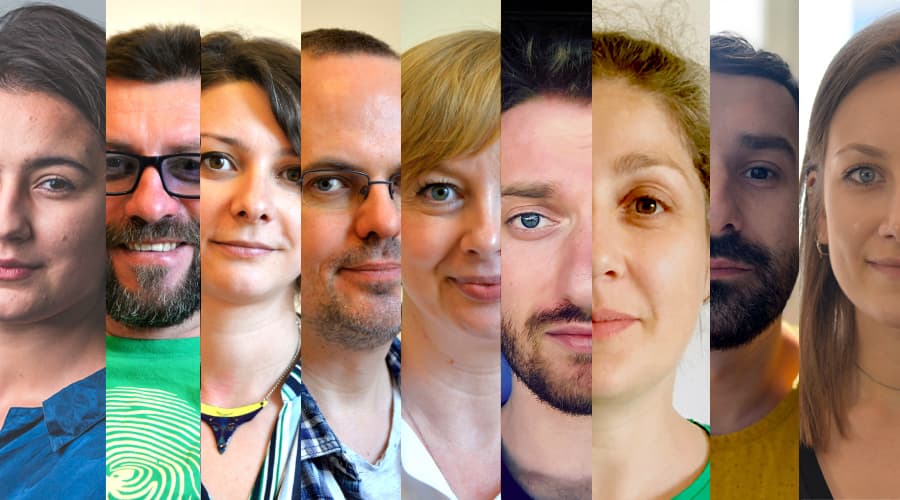
Avem nevoie de ajutorul tău!
Mulți ne citesc, puțini ne susțin. Asta e realitatea. Dar jurnalismul independent și de serviciu public nu se face cu aer, nici cu încurajări, și mai ales nici cu bani de la partide, politicieni sau industriile care creează dependență. Se face, în primul rând, cu bani de la cititori, adică de cei care sunt informați corect, cu mari eforturi, de puținii jurnaliști corecți care au mai rămas în România.
De aceea, este vital pentru noi să fim susținuți de cititorii noștri.
Dacă ne susții cu o sumă mică pe lună sau prin redirecționarea a 3.5% din impozitul tău pe venit, noi vom putea să-ți oferim în continuare jurnalism independent, onest, care merge în profunzime, să ne continuăm lupta contra corupției, plagiatelor, dezinformării, poluării, să facem reportaje imersive despre România reală și să scriem despre oamenii care o transformă în bine. Să dăm zgomotul la o parte și să-ți arătăm ce merită cu adevărat știut din ce se întâmplă în jur.
Ne poți ajuta chiar acum. Orice sumă contează, dar faptul că devii și rămâi abonat PressOne face toată diferența. Poți folosi direct caseta de mai jos sau accesa pagina Susține pentru alte modalități în care ne poți sprijini.
Vrei să ne ajuți? Orice sumă contează.
Share this


